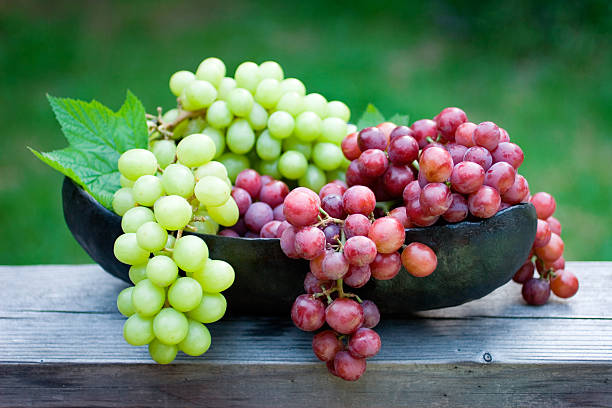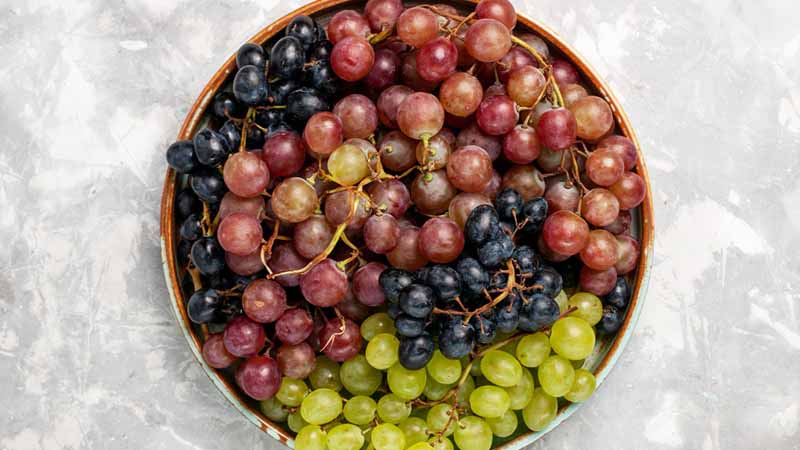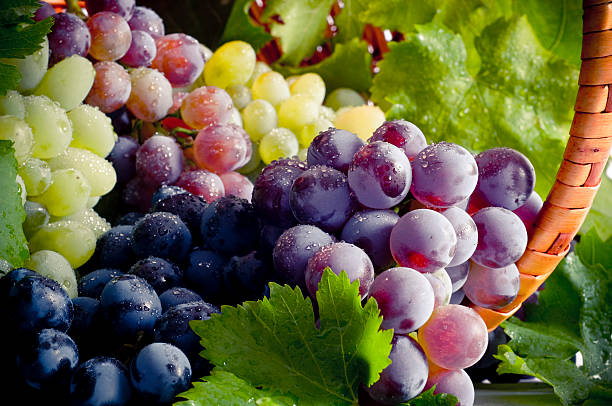
This is a clear and easy overview of grapes as a fruit—looking at their plant details, how they’re grown, health benefits, history, and more.
1. Plant Basics and Classification
- Scientific Grouping:
- Kingdom: Plantae
- Type: Flowering plants (Angiosperms)
- Order: Vitales
- Family: Vitaceae
- Genus: Vitis
- Common Species: Vitis vinifera is the most commonly grown, although others like Vitis labrusca (found in North America) are also used.
Grapes grow on climbing or trailing vines. They have simple, alternating leaves and tendrils that help them cling to supports.

2. Types of Grapes
Grapes come in many types, depending on how they are used:
Table Grapes: These are for eating fresh. Varieties like Thompson Seedless, Red Globe, and Concord are popular. They’re often big, sweet, and may or may not have seeds.
Wine Grapes: These include Cabernet Sauvignon, Merlot, Pinot Noir, and Chardonnay. They’re used to make wine and have special flavours, acidity, and tannins.
Raisin Grapes: These are usually seedless and dried to make raisins. Thompson Seedless is one common type used.
Grape varieties vary in taste, colour (green, red, black, even pink), and resistance to pests and diseases.
3. How Grapes Are Grown
Ideal Conditions:
Climate: Grapes prefer areas with warm, sunny days and cool nights—similar to the Mediterranean.
Soil: They like well-drained soil and can handle many types, though slightly alkaline soil is best.
Growing Methods:
Training & Pruning: Vines are grown along trellises to get more sunlight, better air circulation, and easier harvesting. Pruning each year helps keep the vines healthy and productive.
Water & Fertiliser: Grapes don’t need much water, but some fertiliser is used. Too much can affect the taste of the grapes.
Pests & Diseases:
Common Pests: Moths and aphids can damage vines. Farmers often use eco-friendly methods (called IPM – Integrated Pest Management) to control them.
Diseases: Fungal infections like powdery mildew and bunch rot can be a problem. Good airflow and fungicides help protect the vines.

4. Nutrition and Health
- What’s in Grapes:
- Vitamins: Grapes have vitamin C, K, a little A, and B vitamins.
- Minerals: They contain potassium and manganese.
- Antioxidants: Grapes are rich in resveratrol and flavonoids—these help protect the body.
- Sugar & Fibre: They mostly contain natural sugars (glucose and fructose) and a bit of fibre.
- Health Benefits:
- Heart Health: Antioxidants, especially resveratrol, may protect the heart and blood vessels.
- Fighting Inflammation: Some compounds may help reduce inflammation.
- Cancer Protection: Antioxidants in grapes may help reduce the risk of some cancers.
- Eye Health: Grapes contain lutein and zeaxanthin, which are good for your eyes.
- Note: Grapes are healthy, but because they’re sweet, people with high blood sugar should enjoy them in moderation.
5. History and Culture
Grapes have been important to people for thousands of years:
Ancient Times: Egyptians, Greeks, and Romans all grew grapes—for food, wine, and even religious ceremonies.
Wine: Making wine has been an art for centuries, especially in Southern Europe and the Mediterranean. Wine is often part of celebrations and traditions.
Symbolism: Grapes have been symbols of plenty, fertility, and the cycle of life in many cultures.

6. Economy and Global Production
- Why Grapes Matter:
- Wine Business: Grapes are a big part of the global wine trade, which supports farming, tourism, and exports.
- Fresh & Dried Grapes: Many countries export grapes and raisins, which adds to their economy.
- Top Producing Countries:
- Leaders in Wine Grapes: Italy, Spain, France, and the USA
- Trends: People are now asking for organic and sustainable grapes. Climate change and new farming technology are also affecting how grapes are grown.
7. Uses of Grapes
Grapes are very flexible in how they’re used:
- Fresh: Eaten raw or in fruit salads.
- Juice & Wine: Grapes are crushed and fermented to make juice or wine.
- Raisins: Drying grapes turns them into sweet, chewy raisins.
- Other Products: Grapes are used in health supplements, cosmetics, vinegars, and more.

Conclusion
Grapes are much more than just a tasty fruit. They are an important crop with deep roots in history, health, farming, and the economy. Whether you eat them fresh, sip them as wine, or use them in cooking, grapes continue to play a valuable role in our lives.
Feel free to ask if you’d like to know more about how grapes are grown, processed, or how they help with health.
For more tips, recipes, and fascinating fruit facts, visit Frutifyx.com!
Stay connected with us on YouTube!
Let me know if you’d like any tweaks! 😊
Thank you….!
